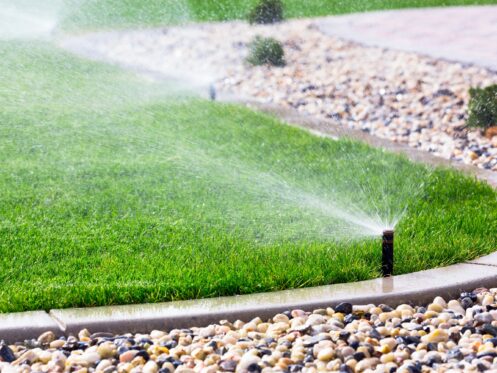The end of winter in Christiansburg, VA, creates challenges for lawns, even on the warm spring days. From December through February, temperatures regularly dip below freezing. With our snowy and icy weather throughout the winter, it creates a heavy blanket that smothers grass for days or weeks. Then the snow will begin to thaw on a warm winter’s day, only to freeze again as the temperatures drop once more.
By early spring, many lawns show signs of winter damage. Compacted soil prevents sufficient air and water circulation. Weakened root systems struggle to support new growth. Patchy areas reveal where snow or salt damage took their toll, and mats of dead grass create barriers to fresh growth.
Taking action in early spring gives your grass the best chance to recover and thrive. With early care, you can transform winter-battered grass into a lush lawn before the summer heat arrives.
Understanding What Winter Did to Your Lawn
Winter takes a serious toll on lawns, with multiple factors working against your grass’s health. The freezing and thawing cycles that characterize Virginia winters particularly damage soil structure. As moisture in the ground repeatedly freezes and expands, melting and contracting, it pushes soil particles together. This creates compaction. This problem is especially severe in the clay-rich soils common throughout the region. Our soil naturally retains more moisture, making dense and hard-packed earth very common. That is not ideal for a verdant lawn.
When snow covers your lawn for extended periods, it also creates perfect conditions for mold and other fungal diseases. Such pathogens thrive in cold and damp environments where grass remains wet for days or weeks. The fungi spread beneath the snow, attacking weakened grass blades and roots. Likewise, cooler post-thaw conditions can be just as bad.
Winter stress significantly impacts plants’ root systems. Cold temperatures force plants into dormancy, but fluctuating conditions can cause them to wake up and waste scarce energy. By spring, grass has often depleted its resources, resulting in shallow and weak root systems.
Visual inspection of your lawn in early spring will reveal several telltale signs of winter damage. You may see brown or gray patches that don’t turn green when other areas do. There may be sparse areas where grass failed to survive. Matted and discolored grass is a possible sign of fungal infection.
Spring Cleanup and Soil Preparation
After winter’s damage, spring cleanup and soil preparation create the foundation for recovery. Start by addressing thatch, the unsightly layer of dead grass and roots that accumulate. When a clump of thatch is thicker than half an inch, it blocks water, nutrients and air from reaching roots. Likewise, it creates a breeding ground for pests and diseases. Use a sturdy rake with stiff tines and apply firm pressure to pull up the thatch from your lawn. For larger areas or severe thatch problems, a dethatching machine may be necessary.
Next, remove all winter debris from your lawn. Clear away fallen branches, lingering leaves and any protective winter mulch applied around trees or shrubs. Cleanup prevents mold development and allows sunlight to reach the grass.
Lawn aeration is perhaps the most crucial step because of our region’s clay-heavy soil. This process creates thousands of small holes in your lawn. Aeration encourages oxygen, water and nutrients to penetrate the root zone. Early spring, as soon as the ground is no longer frozen and has dried somewhat, is the best time for aeration. You can leave the extracted soil on the lawn to break down naturally, returning valuable microorganisms to the earth.
Before applying any treatments, conduct a soil test to determine your lawn’s specific needs. Soil testing reveals the pH level and identifies nutrient deficiencies unique to your property. The results will guide your fertilization choices and help you avoid wasting money on unnecessary products.
Overseeding
Overseeding is a critical step to rejuvenate your winter-damaged lawn. The process introduces new grass without tearing up existing soil. In our area’s climate, cool-season grasses perform best. Tall fescue is particularly well-suited with excellent heat, drought and wear tolerance while maintaining good cold hardiness. Kentucky bluegrass is popular because of its resilience but requires more sunlight. Perennial ryegrass germinates quickly and works well when mixed with other varieties, making it a good choice if your lawn needs immediate help.
To encourage successful overseeding, mow your lawn shorter than usual. Remove grass clippings before applying seed. An even distribution is ideal. After spreading the seed, lightly rake the area to improve seed-to-soil contact or use a roller to press the seeds into the ground.
For bare patches larger than a few inches across, more intensive repair is necessary. The top two inches of soil may need loosening. A small amount of compost in the area will improve soil structure and add nutrients. Next comes the seed grass. Cover the seed with a thin layer of topsoil or compost to maintain moisture.
The goal is to get lawn seeding done while the weather is still regularly in the 60-degree F range. This ensures that the grass will have time to thrive before summer’s heat hits it.
Watering and Fertilizing
Watering is crucial after your spring lawn renovation efforts. Following seeding or aeration, consistent moisture is essential. New grass seedlings have shallow root systems and dry out quickly.
Water deeply but infrequently to encourage roots to grow downward rather than remaining near the surface. Aim for about one inch of water per week. Two to three waterings a week are best. This forces roots to seek water deeper in the soil, creating more drought-resistant grass. Adjust your watering schedule based on rainfall.
Fertilizing your lawn provides essential nutrients that help your lawn recover from winter stress. Based on your soil test results, select a slow-release fertilizer with the appropriate nutrient ratio. A balanced NPK (nitrogen-phosphorus-potassium) ratio like 10-10-10 works well for most lawns unless your soil test indicates specific deficiencies. Be careful not to over-fertilize, though, as excess nutrients can damage grass and lead to runoff.
Maintaining Your Renewed Lawn
Regular mowing at the proper height is crucial for maintaining your newly revived lawn. A height of at least three inches is best because it shades the soil. This discourages weeds from spreading throughout your lawn. Spot-treat weeds rather than applying blanket herbicides whenever possible. Watch for signs of fungal diseases like brown patches or dollar spots.
Continue monitoring soil moisture. Look for areas that dry faster than others because they may need more water. A simple rain gauge can be useful for tracking precipitation. Repeat soil tests annually for the first few years and pivot to once every two if your lawn stays healthy. Soil pH and nutrient levels change over time, so the occasional test is worth the investment.
All Natural Tree Experts has served Southwest Virginia since 2014. We offer numerous lawn services, and tree services as well. From checking for pests to planting, you can trust us to be thorough. Our advice is backed by a certified arborist, too.
Your Christiansburg lawn deserves some care, so contact All Natural Tree Experts today!


